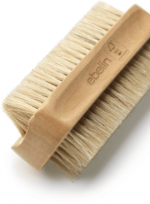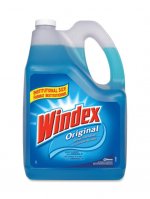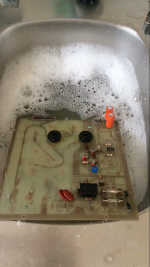Elcaps big and small, dry out over time, both in use and storage and given enough time, the electrolyte vanishes and some types become prone to explode. I've only been an occasional repairer but it's happened to me at the bench, mostly with only small, cheopo types and about 20 times in my recollection. Eventually, I began to use a DBT (dim bulb tester) with a small, incandescent pilot globe to condition the caps before smacking them with a full, peak voltage blast at switch-on. A variac could do just as well if operated wisely but it's cheaper and easier to use an appropriate bulb such as for an oven or refrigerator, if you can find one.
Sometimes with vintage gear, because the old cap's rubber vent seal is blocked and turned to mush, there's a deafening bang as a main smoothing cap becomes a projectile and a shower of tiny foil shards fills the room. Even caps within an expected 20 years service life can blow but usually it's the budget types, where penny-pinching has had a direct effect on safety.
Inside an amplifier case, caps aren't much of a threat unless you are talking about the super-sized caps, which were popular eye candy in the 1970s-90s period. Funny though, that reviewers never seemed to note the hollow sound and feel when you touched some of those monster caps. For one manufacturer, JVC used to squeeze 3 or more smaller caps inside big, impressive looking cans that would do any grenade proud and what's more, there was no vent on the outer can, just the phenolic end plate and maybe the PCB as partial shields in the event of an explosion.
Otherwise, we still find cheap elcaps today that are mostly airspace. There may be one or two smaller caps that may or may not be marked with smaller values and "Joe Master" brand is just one that's been shown online to be faked and guilty. These caps did have a modern form of rupture disc for a vent but it's doubtful whether that could work as intended, if at all. Likewise for caps that are faked for the appearance of originality, as necessary for restorers of veteran radios and audio gear.
In safety matters though, we can't use anecdotal evidence as proof of low safety risk. We need engineering figures and stats before it can be argued or recommended that others are safe to use some "iffy" practice in their restoration work. I could plead ignorance and probably get away with a legal caution but it's unwise to claim that certain practices are OK for newbies, without also drawing attention to the possible, if remote dangers that Tomchr wrote of.
Otherwise, tinkering with the glories and curiosities of the past has sure become a very popular activity in the UK, at least since the 1970s. It seems everyone involved becomes their own passionately opinionated expert on the rights and wrongs of history and restoration work though - making it all quite an amusing cult
Sometimes with vintage gear, because the old cap's rubber vent seal is blocked and turned to mush, there's a deafening bang as a main smoothing cap becomes a projectile and a shower of tiny foil shards fills the room. Even caps within an expected 20 years service life can blow but usually it's the budget types, where penny-pinching has had a direct effect on safety.
Inside an amplifier case, caps aren't much of a threat unless you are talking about the super-sized caps, which were popular eye candy in the 1970s-90s period. Funny though, that reviewers never seemed to note the hollow sound and feel when you touched some of those monster caps. For one manufacturer, JVC used to squeeze 3 or more smaller caps inside big, impressive looking cans that would do any grenade proud and what's more, there was no vent on the outer can, just the phenolic end plate and maybe the PCB as partial shields in the event of an explosion.
Otherwise, we still find cheap elcaps today that are mostly airspace. There may be one or two smaller caps that may or may not be marked with smaller values and "Joe Master" brand is just one that's been shown online to be faked and guilty. These caps did have a modern form of rupture disc for a vent but it's doubtful whether that could work as intended, if at all. Likewise for caps that are faked for the appearance of originality, as necessary for restorers of veteran radios and audio gear.
In safety matters though, we can't use anecdotal evidence as proof of low safety risk. We need engineering figures and stats before it can be argued or recommended that others are safe to use some "iffy" practice in their restoration work. I could plead ignorance and probably get away with a legal caution but it's unwise to claim that certain practices are OK for newbies, without also drawing attention to the possible, if remote dangers that Tomchr wrote of.
Otherwise, tinkering with the glories and curiosities of the past has sure become a very popular activity in the UK, at least since the 1970s. It seems everyone involved becomes their own passionately opinionated expert on the rights and wrongs of history and restoration work though - making it all quite an amusing cult
Last edited:
I've been servicing hifi for years and we always use a vacuum cleaner in conjunction with a small paint brush. That gets rid of pretty much everything. If you wanted perfection, I'd then follow it up with the iso alcohol. As for drink spills, I really don't have a good solution for those as they result in a sticky mess which doesn't clean off, even with solvents.
Probably said before but never use the consumer version which is 70% (and water!) but use the 99% medical quality of isopropyl alcohol. Anything with water will cause oxidation of solder joints.
For some reason even 99% isopropyl I find today causes debris or "striping" so I clean with a cloth just after having cleaned with a brush and the fluid. The best I have ever used was PCB cleaner in spray cans but is was very bad for health/environment.
Tip: for very dirty PCB's a SOFT tooth brush (a new one) and the iso will work wonders. Even better are the brushes for cleaning finger nails especially the version with SOFT natural fibers like the ones as sold under the Ebelin brand name in Germany. Please see the picture. Take care to work as ESD safe as possible also with old analog stuff. The least one can do is to touch a PE connection and to not wear any fleece or static buildup clothing.
In Germany second hand electronic stuff is always sold with a qualification if the device was used in a non smoking/non pet environment. Despite being a mans best friend dogs cause very dirty homes. I just let such devices slip as it is not worth the hassle when stuff is absurdly dirty. The smell is very hard to get rid of.
For some reason even 99% isopropyl I find today causes debris or "striping" so I clean with a cloth just after having cleaned with a brush and the fluid. The best I have ever used was PCB cleaner in spray cans but is was very bad for health/environment.
Tip: for very dirty PCB's a SOFT tooth brush (a new one) and the iso will work wonders. Even better are the brushes for cleaning finger nails especially the version with SOFT natural fibers like the ones as sold under the Ebelin brand name in Germany. Please see the picture. Take care to work as ESD safe as possible also with old analog stuff. The least one can do is to touch a PE connection and to not wear any fleece or static buildup clothing.
In Germany second hand electronic stuff is always sold with a qualification if the device was used in a non smoking/non pet environment. Despite being a mans best friend dogs cause very dirty homes. I just let such devices slip as it is not worth the hassle when stuff is absurdly dirty. The smell is very hard to get rid of.
Attachments
Last edited:
How about using a dishwasher?
It is used to clean up computer motherboards.
It is used to clean up computer motherboards.
Which sort?
As in some means of spraying the meths.
I loosen the dirt by scrubbing with some meths and then prop the board up and spray it down from the top to bottom.
Which sort?
As in some means of spraying the meths.
I loosen the dirt by scrubbing with some meths and then prop the board up and spray it down from the top to bottom.
If water can penetrate el-lyte caps, then the opposite would occur too and it would have been high time replace them anyway and not because of the water, wouldn't it?
edit: ok I think JP meant that the water gets trapped between the el-lyte and pcb as the outer edge of the el-lyte "skirt" edge forms a cavity in between where the water gets trapped, I read it at first as if the water gets inside the can mixing with the lytic which I think is nearly impossible, warm/hot water would increase the pressure inside the el-lyte and resist water from getting into it.
Pressurized air comes in handy, but in lack of proper equipment I usually try my best to blow away excessive water with the mouth from components where it gets easily trapped inside.
edit: ok I think JP meant that the water gets trapped between the el-lyte and pcb as the outer edge of the el-lyte "skirt" edge forms a cavity in between where the water gets trapped, I read it at first as if the water gets inside the can mixing with the lytic which I think is nearly impossible, warm/hot water would increase the pressure inside the el-lyte and resist water from getting into it.
Pressurized air comes in handy, but in lack of proper equipment I usually try my best to blow away excessive water with the mouth from components where it gets easily trapped inside.
Last edited:
- Status
- This old topic is closed. If you want to reopen this topic, contact a moderator using the "Report Post" button.
- Home
- Amplifiers
- Solid State
- Cleaning an Extremely Dirty Amp


